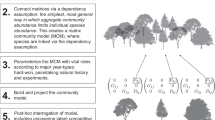Abstract
Matrix models are widely used for demographic analysis of age and stage structured biological populations. Dynamic properties of the model can be summarized by the net reproductive rate R 0. In this paper, we introduce a new method to calculate and analyze the net reproductive rate directly from the life cycle graph of the matrix. We show, with examples, how our method of analysis of R 0 can be used in the design of strategies for controlling invasive species.
Similar content being viewed by others
References
Caswell, H., 1982a. Optimal life histories and the age-specific costs of reproduction. J. Theor. Biol. 98(3), 519–529.
Caswell, H., 1982b. Optimal life histories and the maximization of reproductive value—a general theorem for complex life-cycles. Ecology 63(5), 1218–1222.
Caswell, H., 1984. Optimal life histories and age-specific costs of reproduction—2 extensions. J. Theor. Biol. 107(1), 169–172.
Caswell, H., 2001. Matrix population models: construction, analysis, and interpretation, 2nd edn. Sinauer Associates.
Chen, W., 1976. Applied graph theory; graphs and electrical networks, 2nd edn. North-Holland Pub. Co.
Cushing, J., Zhou, Y., 1994. The net reproductive value and stability in matrix population models. Nat. Res. Model. 8(4), 297–333.
Dinnetz, P., Nilsson, T., 2002. Population viability analysis of Saxifraga cotyledon, a perennial plant with semelparous rosettes. Plant Ecol. 159(1), 61–71.
Hinz, H., 1996. Scentless chamomile, a target weed for biological control in Canada: Factors influencing seedling establishment. In: Proceedings of the IX International Symposium on Biological Control of Weeds, pp. 187–192.
Hinz, H., McClay, A., 2000. Ten years of scentless chamomile: Prospects for the biological control of a weed of cultivated land. In: Proceedings of the X International Symposium on Biological Control of Weeds, pp. 537–550.
Horn, R., Johnson, C., 1985. Matrix Analysis. Cambridge University Press.
Hubbell, S., Werner, P., 1979. Measuring the intrinsic rate of increase of populations with heterogeneous life histories. Am. Nat. 113(2), 277–293.
Krivan, V., Havelka, J., Feb 2000. Leslie model for predatory gall-midge population. Ecol. Modell. 126, 73–77.
Lewis, E., 1977. Network models in population biology. Springer-Verlag.
Li, C., Schneider, H., 2002. Applications of Perron-Frobenius theory to population dynamics. J. Math. Biol. 44(5), 450–462.
Mason, S., Zimmermann, H., 1960. Electronic circuits, signals, and systems. Wiley.
Parker, I., 2000. Invasion dynamics of Cytisus scoparius: a matrix model approach. Ecol. Appl. 10(3), 726–743.
Shea, K., Kelly, D., 1998. Estimating biocontrol agent impact with matrix models: Carduus nutans in New Zealand. Ecol. Appl. 8(3), 824–832.
van den Driessche, P., Watmough, J., Nov 2002. Reproduction numbers and sub-threshold endemic equilibria for compartmental models of disease transmission. Math. Biosci. 180, 29–48.
Werner, P., Caswell, H., 1977. Population-growth rates and age versus stage-distribution models for teasel (Dipsacus sylvestris Huds). Ecology 58(5), 1103–1111.
Author information
Authors and Affiliations
Corresponding author
Rights and permissions
About this article
Cite this article
de-Camino-Beck, T., Lewis, M.A. A New Method for Calculating Net Reproductive Rate from Graph Reduction with Applications to the Control of Invasive Species. Bull. Math. Biol. 69, 1341–1354 (2007). https://doi.org/10.1007/s11538-006-9162-0
Received:
Accepted:
Published:
Issue Date:
DOI: https://doi.org/10.1007/s11538-006-9162-0




